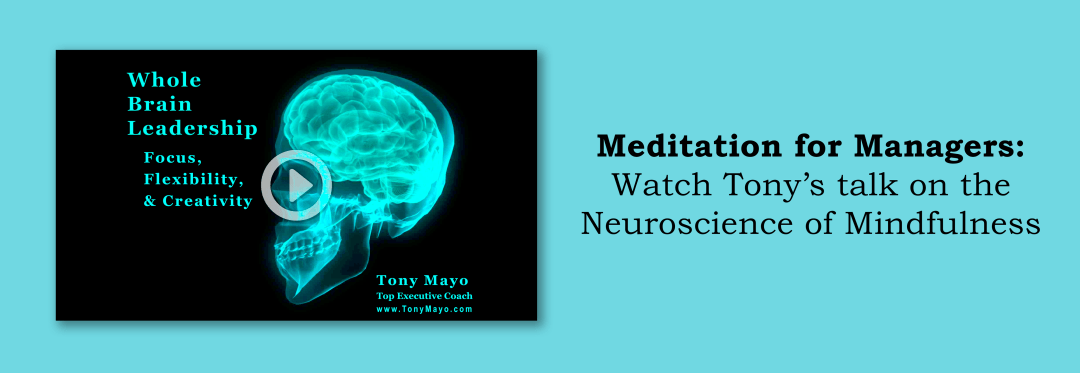by Tony Mayo | Communication, Conversation, & Confrontation, For Business Owners, Leadership Development, Meetings, Team Manager Skills
I was very pleased to see an international expert on software development express the following clear insights into the types of workplaces my executive coaching seeks to foster.
Visionaries are designing organizations for collaboration. These firms remove the bottlenecks imposed by the strict hierarchies of the past. [In hierarchical firms] no one was being rewarded for taking the kind of risks that lead to innovation or other breakthroughs in performance which thrive in a climate of collaboration.
Knowledge workers spend a large proportion of their time seeking information, much of the rest making sense of what they’ve found, and relatively little time in applying what they now know.
Transitioning from a hierarchical way of working … requires letting go of habitual behaviors that may have worked well in the hierarchy, but no longer serve anyone when collaboration becomes a critical part of the work process.
…
[The result is] … humanized work with an emphasis on mastery of our craft, a focus on rapid learning and feedback, delivery of business value (sooner not faster), and close connection to customer needs (even ones the customers’ haven’t noticed yet).
…
— Diana Larsen on Agile Fluency,
Barriers to Agility &
the value of Open Space Technology
in InfoQ
by Tony Mayo | For Business Owners, Stress Management
Would you like to more than triple the chances that your employees will volunteer to help a colleague or a customer? In just two months. For free.
Easy. Encourage your staff to meditate for 20 minutes per day. That is the conclusion from a recent study.
The results were striking. Although only 16 percent of the nonmeditators gave up their seats — an admittedly disheartening fact — the proportion rose to 50 percent among those who had meditated. This increase is impressive not solely because it occurred after only eight weeks of meditation, but also because it did so within the context of a situation known to inhibit considerate behavior: witnessing others ignoring a person in distress — what psychologists call the bystander effect — reduces the odds that any single individual will help.
From Grey Matter: The Morality of Meditation
by David DeSteno, Ph. D. in The New York Times
describing research
by Paul Condon, Ph. D., Northeastern University
published in Psychological Science
See free, easy Meditation Instructions on this blog.

by Tony Mayo | Quotes and Aphorisms
 I use Twitter to share brief messages, not more than two per day. You can have them delivered to your cell phone by text message (SMS) or view them when you visit your free Twitter web page. Create a Twitter account and “follow” TonyMayo.
I use Twitter to share brief messages, not more than two per day. You can have them delivered to your cell phone by text message (SMS) or view them when you visit your free Twitter web page. Create a Twitter account and “follow” TonyMayo.
Here are my recent tweets (messages):
A wealth of information creates a poverty of attention.
—Herbert Simon in 1971
Click here for antidote: http://tr.im/focusin
Be the change you would see in the world. More on Gandhi here.
Character–the willingness to accept responsibility for one’s own life–is the source from which self respect springs. — Joan Didion
Meetings suck for information sharing. Get together for collaboration, creativity, & comradery plus promises. More here.
To fall into despair is just a high-class way of turning into a dope. I choose to laugh, and laugh at myself no less than at others. —Saul Bellow
Always leave some money on the table. You’ll probably come back to that table. –Tony Mayo
If you can’t walk away you’re not negotiating, you’re begging. –Tony Mayo
For more on negotiation click here.
Prior tweets are here, at Twitter Logs.
___
©2010 Tony Mayo
by Tony Mayo | Communication, Conversation, & Confrontation, For Salespeople, Recommended Books, Sales Techniques


The Psychology of Persuasion
by Robert B. Cialdini, Ph.D.

Influence is written as a guidebook for the savvy consumer. The author’s conversational style and frequent sharing of personal experiences will certainly recommend it to that audience. My interest in the work is probably closer to that of the typical reader: as a persuasion professional I am looking for specific ideas to increase my effectiveness. My attention has been richly rewarded.
Professor Cialdini organizes decades of research and experience into six easily comprehended categories of influence techniques. Relevant examples from marketing and sales are used to (more…)







Recent Comments